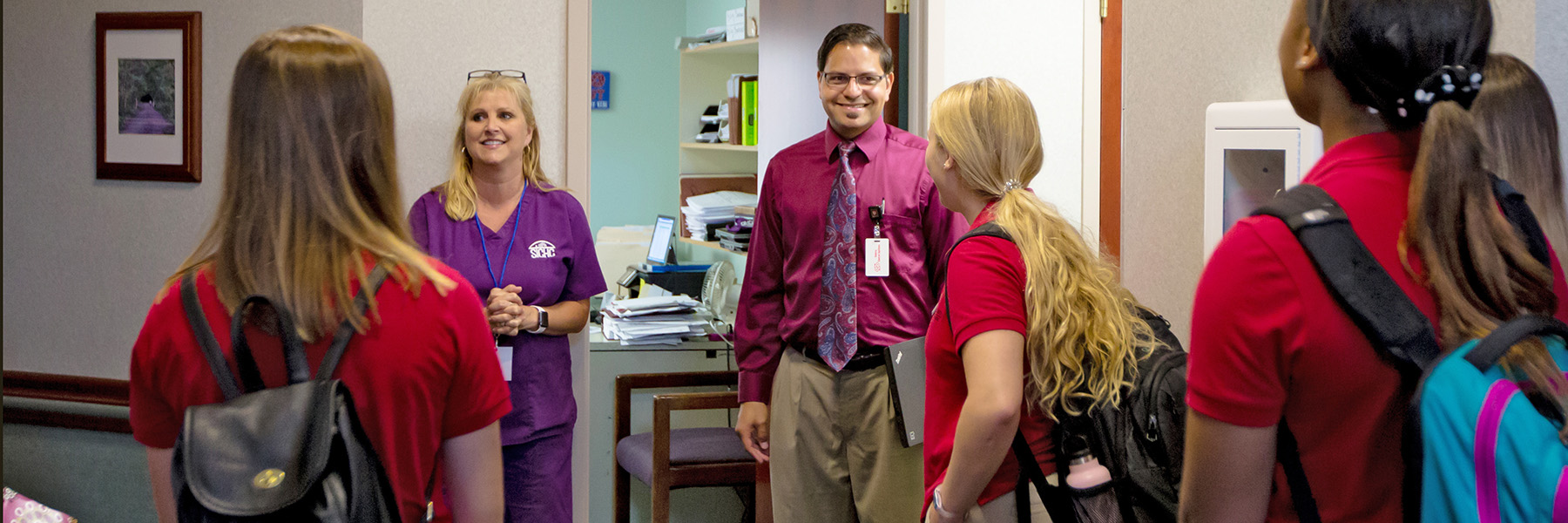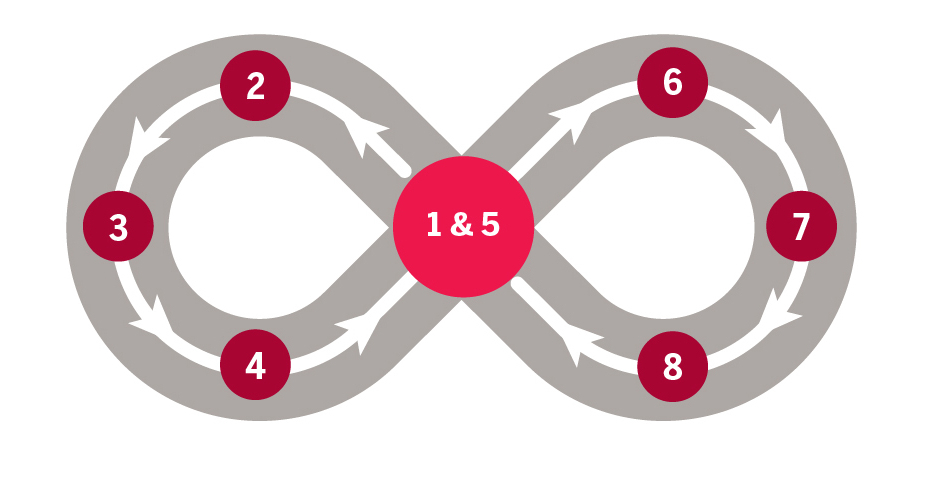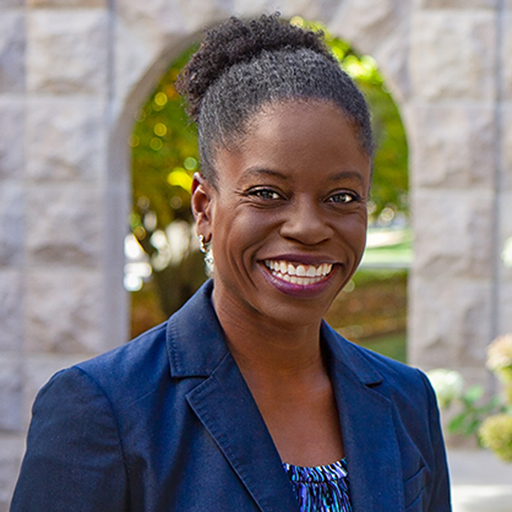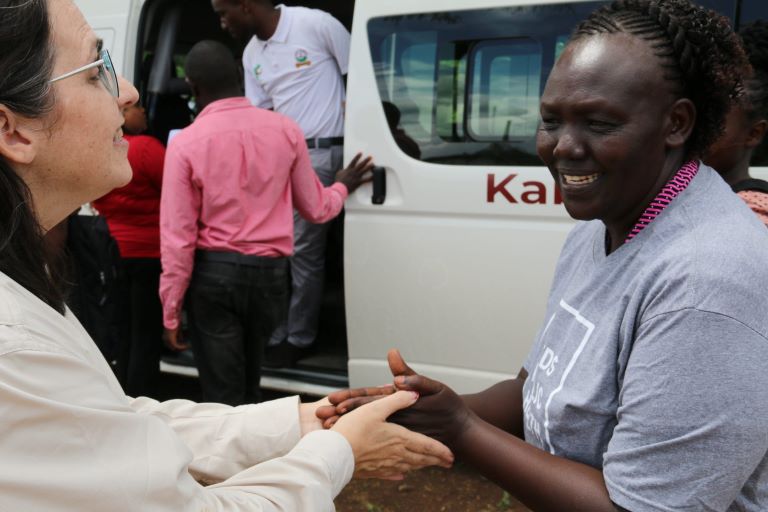Description of the video:
Center for Rural Engagement
CHIPS video transcript
[Soft piano music plays in the background.]
[Video: An aerial view of Washington, in Daviess County, Indiana, shows a row of buildings that house different businesses and some empty storefronts. There are homes just beyond the buildings and a church with a large steeple.]
Priscilla: A CHIP stands for a community health improvement plan.
[Video: Priscilla Barnes is shown being interviewed.]
[Words appear: Priscilla A. Barnes, Associate Professor, IU School of Public Health-Bloomington.]
Priscilla: You can think of it as a guide or a blueprint that communities use to address really big priority areas related to health as identified by a jurisdiction.
[Video: A stop sign is in the foreground at the intersection of Main and Northeast Second Streets in Greensburg, in Decatur County, Indiana. A row of buildings is in the background with cars parked on the street in front of them. An American flag flies from a lamp post on the opposite corner.]
Priscilla: And a jurisdiction can be a county, a region, a city; however that community sees fit.
[Video: Kerry Thomson is shown being interviewed.]
[Words appear: Kerry Thomson, Executive Director, IU Center for Rural Engagement.]
Kerry: The Center for Rural Engagement's role in the CHIP process is one of really engaging deeply with communities to help them build a team of stakeholders that are interested and invested in improving health outcomes in their communities.
[Video: A group of people are shown working and having a discussion around a table, with posters for the Center for Rural Engagement behind them. The posters read “Helping Indiana thrive” and “Building healthy communities.” Then Kerry is shown being interviewed.]
Kerry: So, we do that by working through our faculty, graduate students, and community partners to develop a plan that really envisions a healthier community.
[Video: A photo shows people in a classroom looking towards the lecturer. Then an aerial view shows Decatur County Memorial Hospital.]
Cathy: Utilizing this process to prepare for any other further emergency or a pandemic-like event, I think the number one thing I think is important is knowing your resources for any emergency.
[Video: Cathy Wichman is shown being interviewed.]
[Words appear: Cathy Wichman, Chief Nursing Officer, Decatur County Memorial Hospital.]
Cathy: So, what I have, everyone else needs to know what I have to offer. And for us, we need to know what our community has available.
[Video: An aerial view shows a pedestrian bridge over a small river with people walking on it. A road runs just beyond the bridge and a baseball complex is in the background.]
Cathy: I think if we could have gone back, rewound two years and had this process in place prior, we might have done things differently early on in the pandemic.
[Video: An aerial view shows a water tower with the word Greensburg on it. A railroad track runs next to the water tower and trees and farmland lie beyond that. As the camera pans right, the town of Greensburg comes into view.]
Cathy: It helps us to rely on the relationships that we've created to get the work done. So, I do think just the framework that we're using in itself is a model that we could use going forward in preparation for emergency preparedness.
[Video: Back to Priscilla being interviewed. Then a photo shows three people sitting at a table talking, including a police officer.]
Priscilla: One of the things that we've been able to see is just improvement in how communities gather together and breaking those silos.
[Video: Another photo shows a group of students listening to a nurse during a tour of a health facility.]
Priscilla: So, typically we found two or three organizations really being passionate and interested in moving the needle forward on some critical health issues.
[Video: A photo shows three people sitting at an outdoor table, with one typing on a computer. Then Priscilla is shown again being interviewed.]
Priscilla: But now are seeing more momentum because more sectors are coming to the table, such as transportation, housing, economic development, education. So those non-traditional partners have been a real added value to the community health improvement plan that has not been there before.
[Video: An aerial view shows cows in a field. Then an aerial view of a town is shown. Next, a photo shows a small group of people taking samples and conducting research in a wooded area.]
Christopher: Our health is really the one thing that we truly own. So, whenever we identify gaps in health needs, if we have poor health in the community, that's going to impact all kinds of things related to environment, social, money, employment.
[Video: Christopher Fogle is shown being interviewed.]
[Words appear: Christopher Fogle, Health Educator, Purdue Extension Decatur County.]
Christopher: So, you know, that community engagement piece is where we see adoption either rise or decrease depending on if the community buys into what's being done.
[Video: An aerial view shows Decatur County Memorial Hospital.]
Rex: As a small community hospital in rural Indiana, it's extraordinarily important that we have community support.
[Video: Rex McKinney is shown being interviewed.]
[Words appear: Rex McKinney, Chief Executive Officer, Decatur County Memorial Hospital.]
Rex: And to gain that community support, we have to understand the community health and wellness needs as well as engage the community in addressing those gaps.
[Video: An aerial view shows a row of buildings in Greensburg featuring a variety of businesses. Cars are parked on the street in front of the businesses. Shrubs and flowers are planted along the red brick sidewalk.]
Rex: So, getting the community support from business leaders, individuals, various partnerships, it's extremely important to our success in fulfilling our mission to our community.
[Video: An aerial view shows the downtown square in Greensburg. The clock tower of the courthouse sits in the center.]
Amy: So many of our tactics that were tied to our goals have already come to fruition.
[Video: Amy Shearer is shown being interviewed.]
[Words appear: Amy Shearer, Marketing Manager, Decatur County Memorial Hospital.]
Amy: And we have done a really great job of, in the past, heart screenings, lung screenings, men's, we do a men's health screening every year. So that committee decided that this year we wanted to offer that to women. And so, in August of this year we are doing and women's screening event that is totally free. It will allow women that are underserved, underinsured to be able to have a free annual exam.
[Video: An aerial view shows the Decatur County Fairgrounds with several buildings and a carnival with rides.]
Bryan: We need to be, have our communities be places that people want to live, that want to stay, or want to return to. And a big part of that is having a healthy community, having that, that community infrastructure that allows for healthy practices be it trails, be it parks, greenways.
[Video: A wooded trail is shown, then a wide creek.]
Bryan: But also, programs such as weight loss programs through the hospital, you know, the availability of clinics, mental health is a big thing.
[Video: Bryan Robbins is shown being interviewed.]
[Words appear: Bryan Robbins, Director, Economic Development Corporation of Greensburg/Decatur County.]
Bryan: And if we have those available or can develop those in our community, that makes our community not only healthier as a whole, but more attractive to be a community that people want to live in, want to bring their business to, want to bring their family to.
[Video: An aerial view of the Indiana University Bloomington campus shows large limestone buildings with the sun rising behind them.]
Christopher: Without universities, we wouldn't really have a lot of data to show what decisions need to be made in health or in business in general. Communicate that to the community, to individuals to
say, you know, here's what we're working on and why it's important.
[Video: Kerry is shown being interviewed. Then an aerial view shows the IU School of Public Health-Bloomington. Next, nursing students are seen working in a mock hospital room.]
Kerry: Frequently, a lot of the issues identified by communities are well addressed by the assets that we have in the School of Public Health, the School of Nursing, Social Work.
[Video: The outside of a building is shown featuring a wall of windows, revealing a design lab inside. Then, a photo shows two students in a park.]
Kerry: And, surprisingly perhaps to some, in the School of Art, Architecture, and Design and in our expertise in parks and recreation.
[Video: Back to Kerry being interviewed.]
Kerry: And it's important to know that this is a planning process, but that Indiana University through these schools, is invested and active from planning all the way through implementation.
[Video: Bryant Niehoff is shown being interviewed.]
[Words appear: Bryant Niehoff, Executive Director, Daviess County Economic Development Corporation.]
Bryant: It's critical that we have buy-in from the public and we engage them in these processes, specifically as it relates to health.
[Video: A doctor is shown talking to people in the reception area of the doctor’s office.]
Bryant: Because a community's health is key to our economic development successes.
[Video: A group of people sit around a table talking.]
Bryant: So, it's been phenomenal just to, to see all of those folks come around that, that same table, that same computer screen, right.
[Video: A photo shows three students talk with a man outside his home.]
Bryant: And for IU to help facilitate that conversation has just been critical.
[Video: Tracy Conroy is shown being interviewed.]
[Words appear: Tracy Conroy, Chief Executive Officer, Daviess County Hospital.]
Tracy: Through our community health needs assessment, we've identified two top priorities.
[Video: A group of people sit at a table listening to a speaker. Then the speaker is shown holding a vial of medicine, displaying it to the group.]
Tracy: The first one being substance abuse, both education and the treatment, and then also mental health.
[Video: People are shown at a meeting, having discussions in small groups in a room with several tables.]
Nancy: With this, we have pursued a couple of different grants.
[Video: Nancy Devine is shown being interviewed.]
[Words appear: Nancy M. Devine, Chief Nursing Officer, Daviess Community Hospital.]
Nancy: Those grants are helping us to facilitate some peer recovery resources.
[Video: A child runs to an adult for a hug while two others look on. Then, back to Nancy being interviewed.]
Nancy: It's going to bring those groups together and make a stronger resource for those who are dealing
with addictions.
[Video: Priscilla is shown being interviewed.]
Priscilla: And because of that, we're able to secure federal funding to create a stronger recovery community that provides opportunities for increased education, increased mentoring, and support of peer recovery coaches. And then also more opportunities to strengthen local infrastructure to address substance use and mental health.
[Video: An aerial view shows a water tower with the word Washington on it. The high school gymnasium is near the water tower and a large pool is in the background.]
Brian: Being back in my own community, be able to help people in my community is a big thing for me.
[Video: Brian Peek is shown being interviewed.]
[Words appear: Brian Peek, Peer Recovery Services, Daviess Community Hospital.]
Brian: So, I like doing the peer recovery work because you get to walk with people and you get to take them to treatment centers, you get to see them come home, and you get to walk with them day in, day out. So that's a very rewarding thing for me.
[Video: Tracy and Nancy are seen talking as they walk down the hallway at the hospital.]
Tracy: So, I just love the community support, the camaraderie, and then the collaboration that we have.
[Video: Kerry is shown being interviewed.]
Kerry: I think it's important to understand that the community health improvement plan process is so impactful because it is custom to a specific community.
[Video: An aerial view shows Daviess Community Hospital.]
Kerry: It's their vision that they're achieving. But it's a replicable process that any community can do in order to improve community health.
[Video: Suzanne Crouch is shown speaking to the camera, with the American flag and Indiana flag behind her.]
[Words appear: Suzanne Crouch, Lieutenant Governor, State of Indiana.]
Suzanne: When Hoosiers unite and work together, for real solutions, we can overcome even the most difficult challenges.
[Video: A photo shows people listening to a lecturer during a presentation. Then an aerial view shows a pond with a miniature lighthouse on the shore and a building on the other side of the pond.]
Suzanne: Each plan includes strategies that fit local needs and draw on the strengths our resilient rural communities already possess. It is these same strengths that make rural Indiana a big reason why our state is so successful.
[Video: Kerry is shown being interviewed.]
Kerry: The Indiana University Center for Rural Engagement wishes to thank Dr. Priscilla Barnes, the School of
Public Health, our community partners across rural Indiana, the state of Indiana, and the Office of Community and Rural Affairs for making these transformative health initiatives possible.
[Video: The screen goes black. A red square bounces around the screen, revealing photos inside the square. The photos show scenes of rural Indiana towns, people in those communities, and IU students. The square bounces to the middle of the screen and turns black. The IU Center for Rural Engagement logo appears along with the website address rural dot Indiana dot e d u.]
[End of transcript.]






